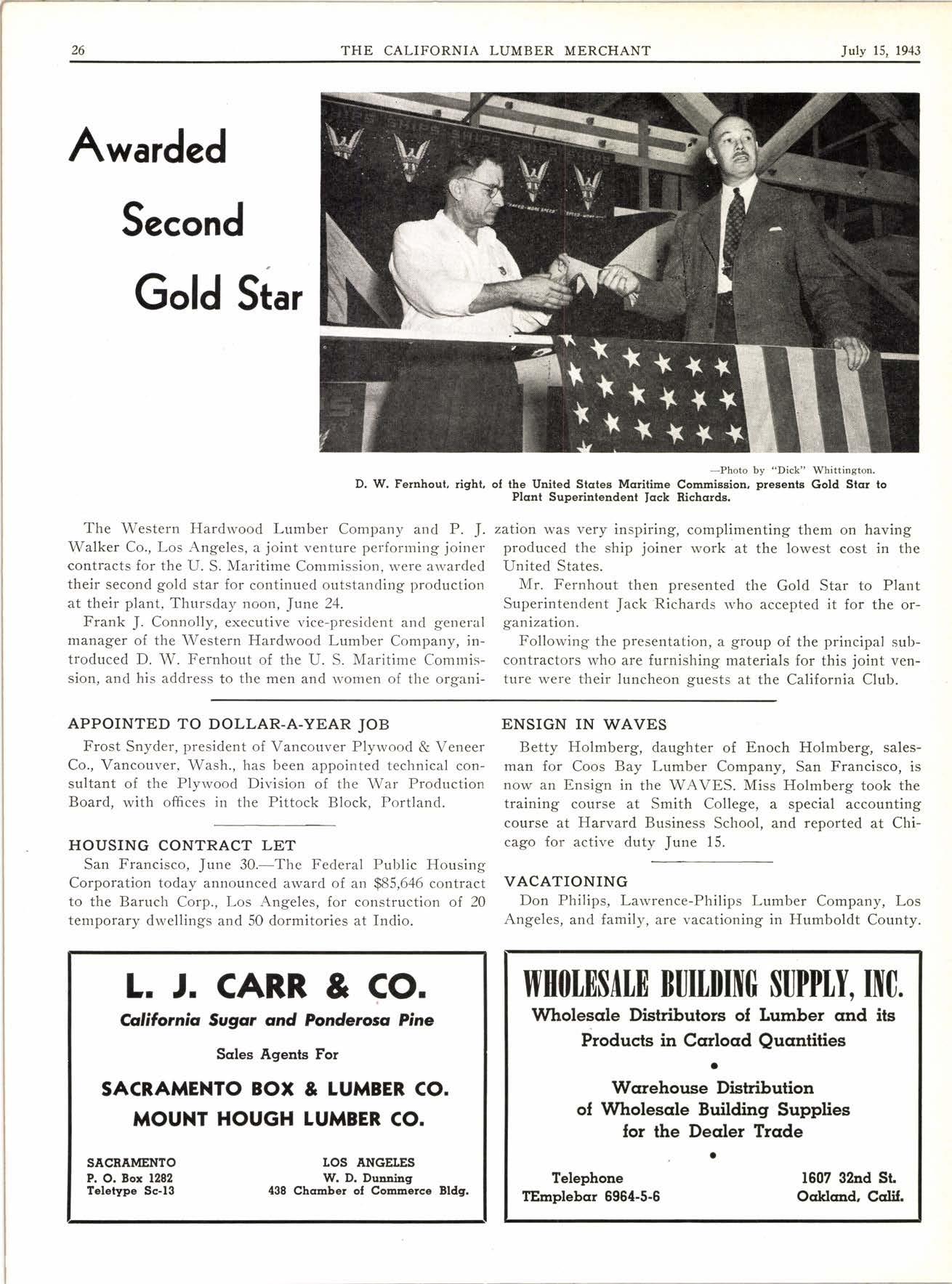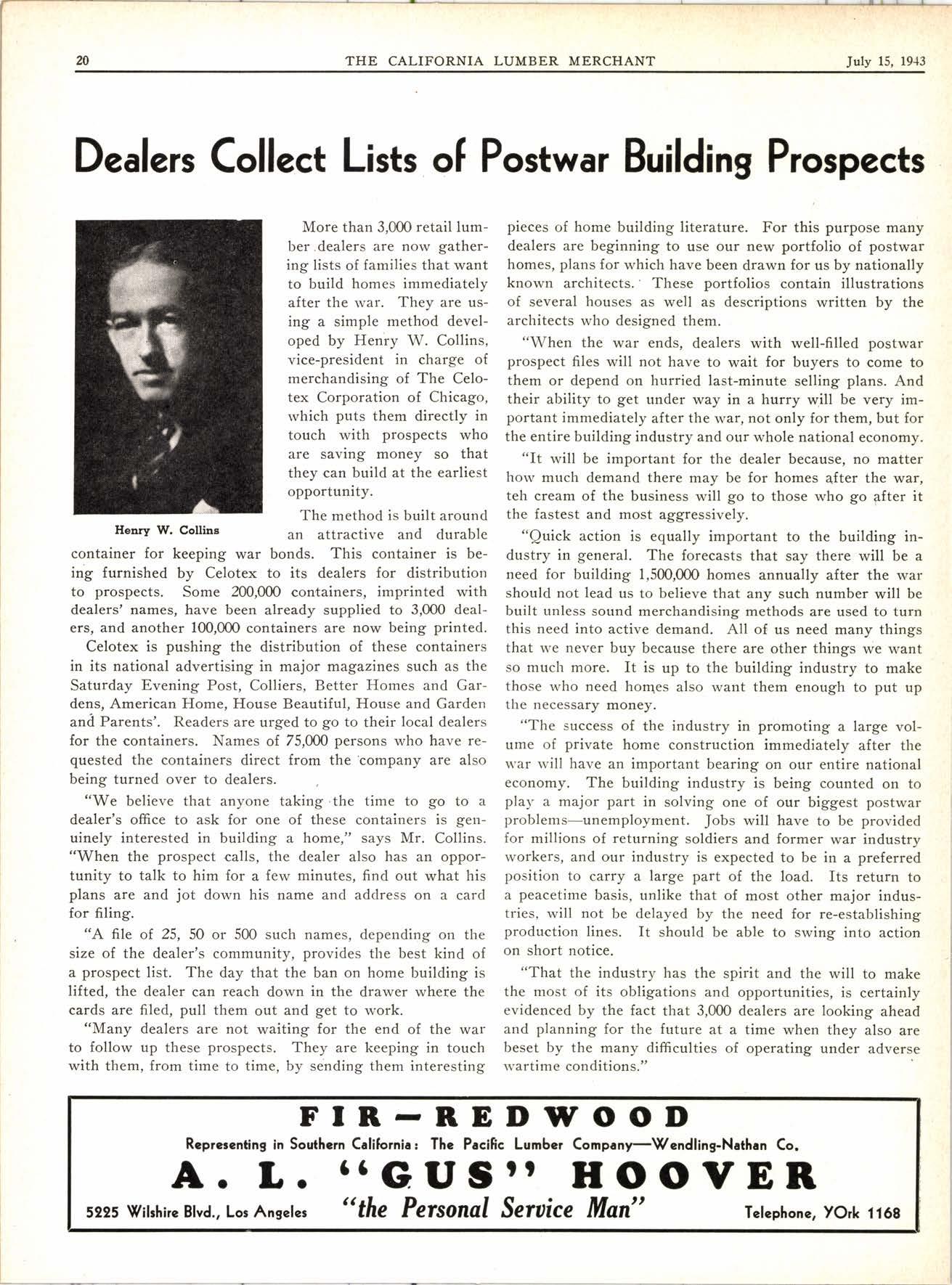
3 minute read
HAMMOND LUMBER COMPANY
MANUTACTT'RERS OT DIAIVIOND.H BRAND REDWOOD CALIFORNIA REDWOOD
Mitlg crt Scurrocr cnrd Eurekcr, Ccrlilornicr
SAN FRANCISCO {17 Montgonery SL
DOuglcs 3388
REDUT(I(ID DISIRIBUTORS tTD. Pure Oil Building CHICAGO, IIJINOEI
Menberr-Cclilomic Bedwood Aroclction-Bedwood Erport Conpcrry mum Price Regulation No. 215 in two specified geographical areas, cover all grades and sizes of softwood lumber which are now under dollars-and-cents ceilings at the mill level, and all sales out of yard stock which were not already covered in Maximum Price Regulation No. 215 prior to the revision. (Maximum Price Regulation No. 215 previously covered only sales out of yard stock of softwood lumber in quantities of 5,000 board feet or over to six classes of buyers who normally purchased in large quantities')
The new interim ceilings are: the f.o.b. mill maximum price of a species, grade and size, plus carlot freight from a sp€cified basing point to the yard, plus a $5 per 1,000 board feet handling charge, plus a "specified percentage mark-up."
The "specified percentage mark-ups" which may be used with the other components in computing interim ceiling prices in the North Central and North Atlantic Regions are as follows:
For "commons" in quantities of 1,000 board feet and over, 30 per cent.
For "uppers" in quantities of 1,000 board feet and over, 4O per cent.
For all grades in quantities under 1,000 board feet, 50 per cent.
In addition, an extra 10 per cent mark-up is permitted on sales involving $7.50 or less.
Eventually similar "interim ceilings," tailored to meet local conditions, will be provided for yards in other geographical areas.
Uniform Mark-Up for Wholesale and'CPA" Yards
In another addition to the provisions governing yard sales of softwood lumber by retail yards, Revised Maximum Price Regulation No. 215 establishes a uniform maximum mark-up of $5 per 1,000 board feet and 1O per cent on all sales by wholesale yards and "CPA" yards located anyrvhere in the United States.
OPA said this new uniform maximum mark-up for wholesale and "CPA" yards would reduce their maximum prices on small sales, but will increase to 10 per cent from 5 per cent their mark-up on sales to other yards. Sales to other yards are usually large lot sales, and constitute the major part of the wholesale yards' business.
(Note: A "CPA" yard is a yard engaged in stock-piling lumber for distribution to consumers under directives from the War Department.)
Additional Working Charges
The following changes are made in working charges applicable to sales by yards in the North Central and North Atlantic regions
1. A new set of higher "working" charges is established for sales carrying mark-ups of higher than $5 per 1,000 board feet plus 10 per cent.
Studies disclosed that the cost of milling and performing other work is considerably higher in small sales than in the large-volume wholesale type of sale, and the revised regulation makes adjustments accordingly, OPA said.
2. A schedule of specific "set-up" charges is provided for small quantity orders.
Previously on quantities under 2,000 board feet a charge for working lumber could be made as if. 2,m feet had been processed, OPA pointed out. This, however, proved excessive in certain cases, such as special workings, where the rvorking charge was high.
Compensation for individual workings on small cluantity orders has now been calculated, and specific charges applicable on specific quantity orders ar6 set forth in the regulation.
Sending Out Pledge Posters
The Southern California Retail Lumber Association is sending out attractive posters to those retail lumber dealers rvho have signed the pledge to conserve automotive equipment for the duration as covered by the regulations of the Office of Defense Transportation. The posters carry a copy of the pledge.
Rail ShilDers OUALITY FIR YARD STOCK
ll!
tOa
D.
Northonr Callloral,a lrtrootnllvo o. L aussttM
Bouilrra c"m'.F.r.trtati?.
11 Kittens Initiated at San Francisco Concat
A successful concatenation was. held by San Francisco members of International Hoo-Hoo at Hotel Whitcomb, San Francisco, June 25. Eleven Kittens were initiated and several old members were reinstated. There was an attendance of about 60, and the enthusiasm shown indicates that there is still a good deal of interest in Hoo-Hoo. Credit should be given to the committee which worked hard to make the aftair a success,
The concatenation was held at 5:39 p.m., and was followed by dinner and some good class entertainment. Frank OfConnor was toastmaster.
E. S. McBride of Davis, Calif., Supreme Jabberwock, was on honored guest, and gave a short talk on Hoo-Hoo.
The Nine which put on the initiation ceremony consisted of the following: Vicegerent Snark, Carl Warden; Senior Hoo-Hoo, Bert Bryan; Junior Hoo-Hoo, Lewis Godard; Jabberwock, Seth Butler, Gurdon, Charles Lindsay; Bojum, Henry M. Hink; Arcanoper, Fritz Dettmann; Custocatian, Larue Woodson; Scrivenoter, Paul Overend.
The Kittens were: Robert Nelson, Hobbs Wall Lumber Co., San Francisco; P. R. (Bob) Kahn, Forsyth Hardwood Co., San Francisco; Richard Mussallem, Smith Lumber Co., San Francisco; Tom Hogan III, Hogan Lumber Co., Oakland; Bob Evju, James L. Hall, San Francisco; Earl Chalfan, E. K. Wood Lumber Co., Oakland; D. Normen Cords, Wendling-Nathan Co., San Francisco; Samuel Chaney, California Redwood Association, San Francisco; Bob Grant, Smith Lumber Co., Oakland; Henry Barg, Smith & Pitcher, San Francisco; Tom Branson, Melrose Lumber Co., Oakland.









